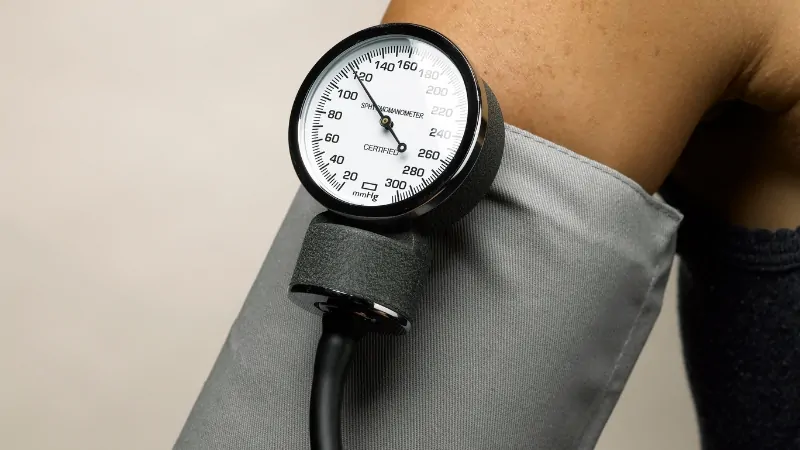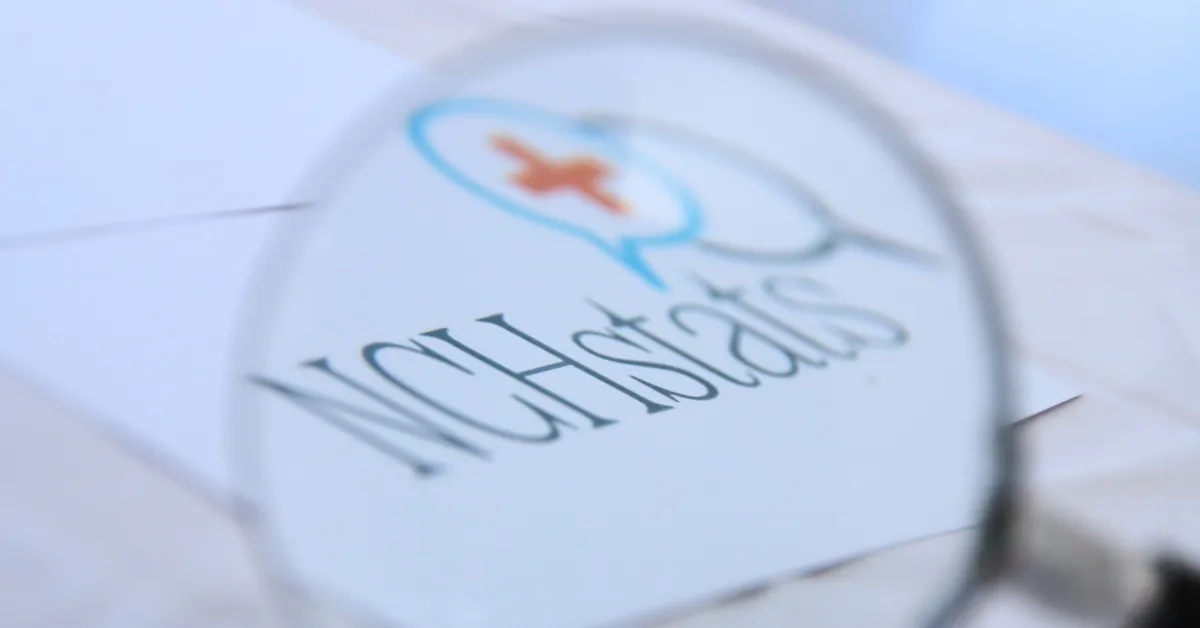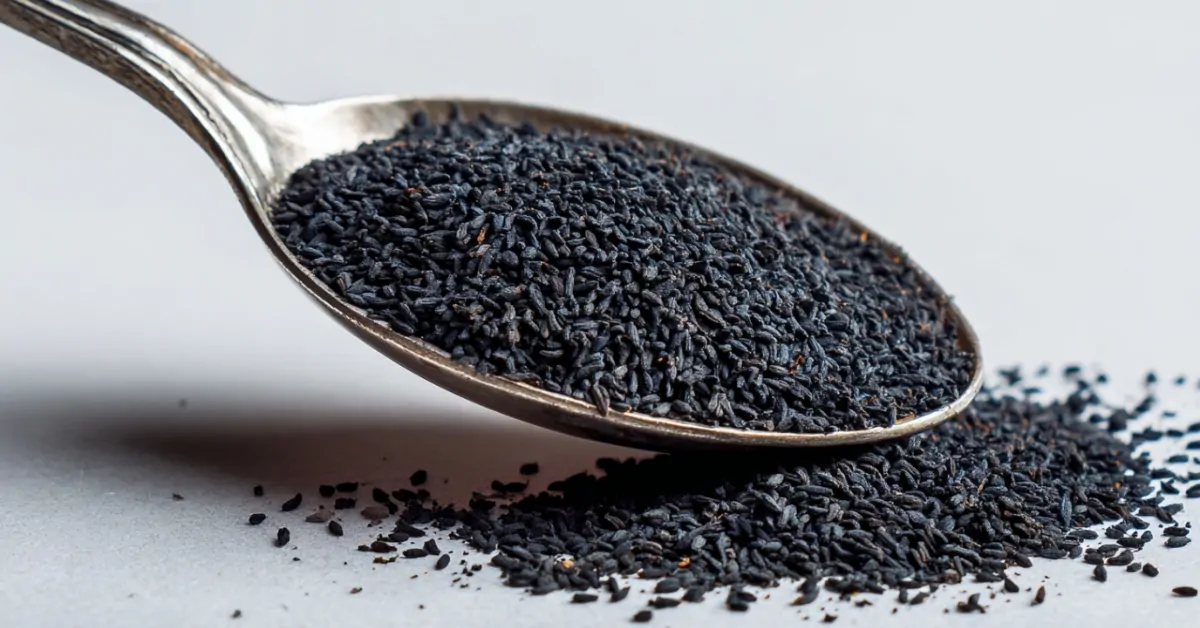Blood pressure (BP) is a key indicator of cardiovascular health. It represents the force that the circulating blood applies against the walls of your arteries with each heartbeat. This pressure is necessary to keep blood flowing throughout the body, delivering oxygen and nutrients to vital organs.
Blood pressure is recorded in millimeters of mercury (mm Hg) and always expressed as two numbers in a fraction format—for example, 120/80 mm Hg. The top (systolic) number measures the pressure in your arteries during the active contraction of your heart, when blood is being pumped out to the body.
The bottom (diastolic) number reflects the pressure in the arteries while your heart is at rest between beats, when the heart muscle relaxes and fills with blood.
- Systolic pressure (“contraction phase”): This occurs when the heart contracts forcefully to push blood out, generating the highest pressure in your arteries.
- Diastolic pressure (“relaxation phase”): This measures the pressure when the heart relaxes between contractions, representing the lowest pressure in your arteries.
According to the American Heart Association (AHA) guidelines updated in 2017, the target for healthy adults is to maintain a blood pressure level below 120/80 mmHg. Here’s how the categories break down:
- Normal: Less than 120/80 mm Hg
- Elevated: Systolic between 120-129 mm Hg and diastolic less than 80 mm Hg
- Hypertension (High Blood Pressure) Stage 1: Systolic 130 mm Hg or higher, or diastolic 80 mm Hg or higher
Consistently high blood pressure, known as hypertension, increases the risk for heart attack, stroke, kidney disease, and other health problems. It’s often called the “silent killer” because it may not show noticeable symptoms until significant damage has occurred.
Heart rate (pulse) is another important cardiovascular measurement. It indicates how many times your heart beats in one minute (beats per minute, BPM). Heart rate can fluctuate depending on various factors, including age, fitness level, activity level, stress, and even the time of day.
Typical resting heart rate ranges are:
- Adults (18 years and older): 60–100 BPM
Well-trained athletes may have resting heart rates closer to 40–60 BPM due to more efficient heart function. - Children (6 to 15 years): 70–100 BPM
Younger children and infants generally have higher normal ranges.
A resting heart rate outside the normal range can signal potential health concerns.
For example, a consistently high heart rate (tachycardia) or unusually low rate (bradycardia) could warrant further evaluation, especially if accompanied by symptoms like dizziness or shortness of breath.
Ideal Blood Pressure for Your Age?
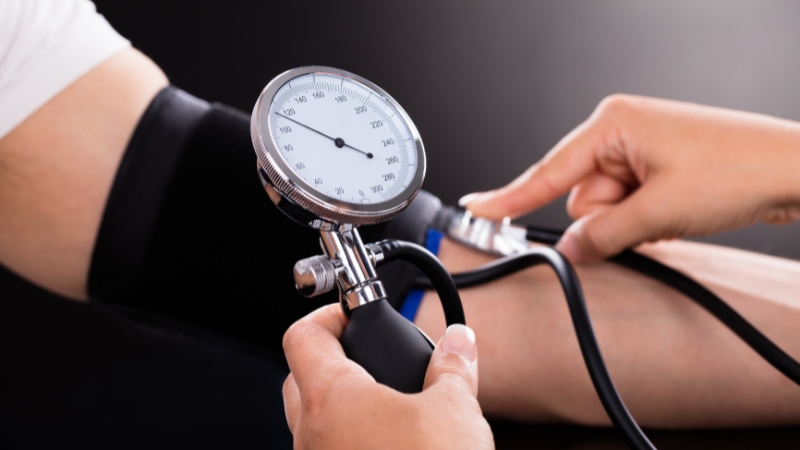
While the American Heart Association (AHA) currently recommends that all adults aim for a blood pressure reading below 120/80 mm Hg, your age and gender can influence what’s considered “ideal” for you.
Blood pressure tends to change as you get older due to changes in blood vessels, hormone levels, and overall health. Historically, some guidelines included slightly higher “normal” values for older adults, but the main goal remains: keep your blood pressure in a healthy range to reduce your risk of heart disease and stroke.
Below, you’ll find estimated average blood pressure values for adults by age and gender, based on earlier AHA guidance. Remember, these are general reference points—individual targets may differ depending on your health history, lifestyle, and any underlying conditions. If you’re unsure about your target, talk to your healthcare provider.
Ideal Blood Pressure by Age and Gender
Knowing the ideal blood pressure for men and the ideal blood pressure for women can help you assess your heart health more accurately as you age. While the American Heart Association recommends a target below 120/80 mm Hg for all adults, average blood pressure can differ slightly by gender and age group.
Below is a chart showing the estimated ideal blood pressure by age for men and women:

Key:
- SBP = Systolic Blood Pressure (upper number, measured during heart contraction)
- DBP = Diastolic Blood Pressure (lower number, measured when the heart relaxes)
If your readings are within or below these ranges, you are likely maintaining a healthy cardiovascular system for your age and gender. The ideal blood pressure for men may trend slightly higher than the ideal blood pressure for women in certain age groups, but both should ideally remain under 120/80 mm Hg to minimize the risk of heart attack, stroke, and other serious conditions.
Remember: Even though slight increases are common as you age, numbers in the hypertension range (130/80 mm Hg or above) should prompt a conversation with your healthcare provider, regardless of gender.
Why Does Blood Pressure Often Increase with Age?
As people age, arteries naturally become stiffer and less flexible, making it harder for blood to flow smoothly. Other factors, such as weight gain, less physical activity, higher salt intake, or underlying medical issues, can also contribute.
Remember:
- These values are averages and may not apply to everyone.
- It’s important to monitor your blood pressure regularly and work with your doctor to set targets right for you, especially if you have risk factors like diabetes, kidney disease, or a family history of hypertension.
What Is a Good Pulse Rate by Age?
Heart rate—or pulse—is the number of times your heart beats per minute (BPM). It’s an important measure of heart health, often checked alongside blood pressure.
For most healthy adults aged 15 and older, a normal resting heart rate falls between 60 and 100 beats per minute, according to the American Heart Association.
However, what’s “normal” can vary by age, activity level, fitness, and certain health conditions.
Why Does Heart Rate Vary?
- Fitness: Athletes and very fit individuals often have lower resting heart rates (sometimes as low as 40–60 BPM) due to more efficient heart function.
- Medications: Certain medications—like beta-blockers—can slow the heart rate.
- Health conditions: Some illnesses, such as hypothyroidism or sick sinus syndrome, may cause abnormally low pulse rates.
- Age: Children and infants naturally have faster heart rates, which gradually slow as they grow.
Normal Resting Heart Rate by Age
Here’s a chart showing typical resting heart rate ranges for various age groups:
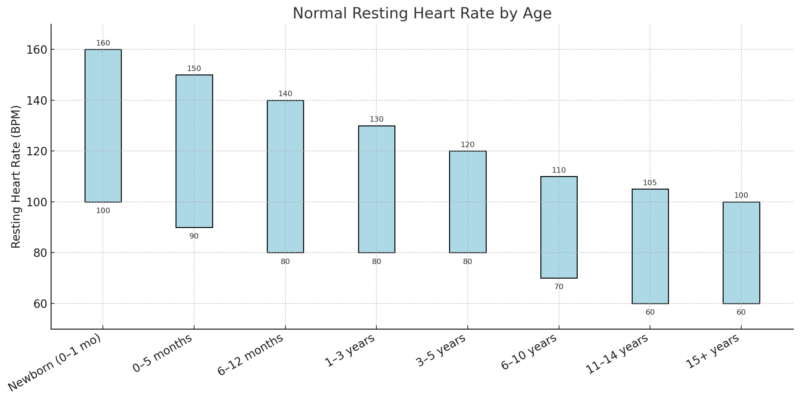
Pulse and Blood Pressure for Seniors
If you’re age 70 or older, it’s especially important to know your numbers. For a 70-year-old adult:
- Normal resting heart rate: 75–128 BPM
- Maximum predicted heart rate: 150 BPM
- Normal blood pressure: Below 120/80 mm Hg
Maintaining a pulse and blood pressure within these ranges helps protect heart and brain health and can lower the risk of heart attack, stroke, and other complications.
Target Heart Rate Zone by Age
When exercising, your target heart rate zone is the range your heart rate should fall into for safe and effective aerobic activity.
The maximum heart rate is typically calculated as 220 minus your age.
Below is a chart showing the estimated target heart rate zones and predicted maximum heart rates by age:
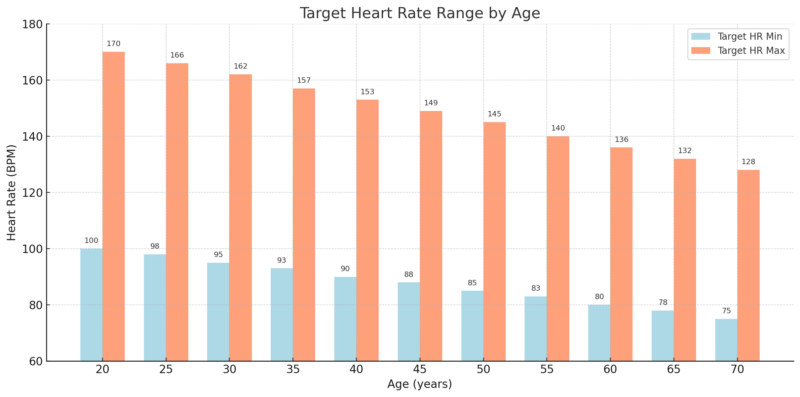
Key Factors That Influence Blood Pressure
Many different factors can affect your average blood pressure—some you can control, and others you cannot.
Here’s a comprehensive table outlining the main factors that impact blood pressure, with concise explanations for each:
| Factor | How It Influences Blood Pressure |
| Age | BP typically rises as you get older due to changes in blood vessel elasticity and overall cardiovascular function. |
| Gender | Women generally have lower BP than men until menopause, after which women’s BP may rise above men’s, according to the AHA journal. |
| Genetics/Family History | A family history of hypertension increases your risk of developing high blood pressure. |
| Weight | Being overweight or obese raises BP by increasing the workload on the heart and blood vessels. |
| Diurnal Variation | BP tends to be lower in the morning and gradually rises throughout the day due to natural body rhythms. |
| Stress & Emotions | Stress, fear, anger, and other strong emotions can temporarily spike BP by activating the sympathetic nervous system. |
| Physical Activity | Exercise increases BP during the activity, but regular exercise helps keep resting BP in the normal range. |
| Pregnancy | Hormonal changes during pregnancy can lower BP, but some women may develop pregnancy-induced hypertension. |
| Chronic Diseases | Conditions like diabetes, kidney disease, thyroid disorders, and certain endocrine issues can raise BP. |
| Medications | Some drugs (NSAIDs, antidepressants, steroids, etc.) may increase BP as a side effect. |
| Alcohol & Tobacco | Excessive drinking and smoking both contribute to higher BP and long-term cardiovascular risks. |
5 Categories of Blood Pressure
View this post on Instagram
A post shared by The Addictive Brain | Science Communication (@theaddictivebrain)
Blood pressure is classified into five main categories, based on guidelines from the American Heart Association. Each range signals different levels of health risk and may require specific action.
| Category | Systolic (mm Hg) | Diastolic (mm Hg) | What It Means |
| Normal | < 120 | < 80 | Healthy range, low risk |
| Elevated | 120–129 | < 80 | Higher risk for hypertension if not addressed |
| Hypertension Stage 1 | 130–139 | 80–89 | Early high BP often needs lifestyle changes |
| Hypertension Stage 2 | ≥ 140 | ≥ 90 | Consistently high BP usually needs medication |
| Hypertensive Crisis | > 180 | and/or > 120 | Medical emergency—seek care immediately |
What do these categories mean for your health?
- If you’re in the normal range, maintain healthy habits and get regular checks.
- Elevated BP doesn’t mean you have hypertension yet, but it’s a warning—exercise, manage stress, and watch your diet.
- Hypertension Stage 1 often calls for lifestyle changes, and sometimes medication if you have other risk factors.
- Stage 2 almost always requires medication and more aggressive intervention.
- Hypertensive crisis is an emergency: seek help immediately, especially if you feel chest pain, vision changes, or confusion.
Types of Abnormal Heart Rate (Arrhythmia)
A heart rhythm outside the normal range is called an arrhythmia. There are several main types, each with different causes and risks.
| Type | Definition |
| Bradycardia | Slow heart rate (< 60 BPM) |
| Tachycardia | Fast heart rate (> 100 BPM) |
| Atrial/Supraventricular Tachycardia (SVT) | Fast rhythm from the upper heart chambers |
| Sinus Tachycardia | Normal, but faster than usual |
| Ventricular Tachycardia | Fast rhythm from the lower chambers |
More common arrhythmias explained:
- Bradycardia means your heart beats too slowly—sometimes normal in athletes, but can cause fatigue, dizziness, or even fainting if severe. In older adults or those with heart disease, it may need a pacemaker.
- Tachycardia is a faster-than-normal heartbeat. Sinus tachycardia is usually a normal response to exercise, fever, or stress. Other forms, like SVT or ventricular tachycardia, are more serious and can cause palpitations, chest pain, or even sudden cardiac arrest.
- Atrial Fibrillation (AFib) and Atrial Flutter are common irregular heart rhythms in adults, especially with age or high blood pressure. They increase stroke risk and often need blood thinners or medications to control rate and rhythm.
- Ventricular Fibrillation (VFib) is a medical emergency. The heart quivers instead of pumping effectively—this requires immediate defibrillation.
Causes and risks:
Arrhythmias may be triggered by heart disease, thyroid disorders, electrolyte imbalances, certain medications, stimulants (like caffeine), or even genetics.
Some are benign, but others—especially if they cause symptoms like fainting or chest pain—can be life-threatening.
Blood Pressure and Stroke: The Critical Connection
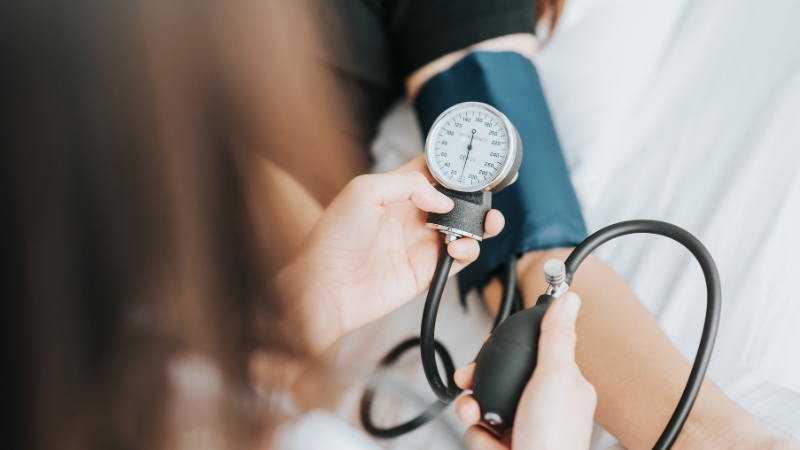
High blood pressure is a leading cause of many serious health conditions, and one of the most dangerous is stroke. Consistently elevated blood pressure puts extra strain on blood vessels throughout your body—including those in the brain—making them more likely to become blocked or rupture.
How Does a Stroke Happen?
There are two primary types of stroke:
- Ischemic stroke: This occurs when a blood clot narrows or completely blocks an artery in the brain, cutting off oxygen and causing brain cells to die.
- Hemorrhagic stroke: In this case, a blood vessel in the brain bursts, which not only deprives a section of the brain of oxygen but also causes pressure inside the skull that can further damage brain tissue.
Both types of stroke can cause rapid and severe brain injury, leading to permanent disability or even death.
What is “Stroke-Level” Blood Pressure?
While multiple factors influence your risk for stroke, having a blood pressure reading consistently above 130/80 mm Hg can significantly increase the likelihood of having a stroke.
A reading over 180/120 mm Hg is considered a hypertensive crisis—a medical emergency that dramatically raises the risk of stroke and other life-threatening complications.
Keeping your blood pressure in a healthy range is one of the best ways to lower your stroke risk.
Why the Diastolic Number Matters
Most people pay close attention to the systolic (upper) number in a blood pressure reading, but the diastolic (lower) number is equally important. Both numbers play a key role in your overall risk.
For example:
- A reading of 140/70 is not healthy, since the systolic number (140) is too high.
- A reading of 119/90 is also not ideal. Even though the systolic number is normal, the elevated diastolic (90) qualifies as hypertension.
So, what is an alarming diastolic number?
If your blood pressure ever exceeds 180/120 mm Hg, you are in hypertensive crisis territory—this is a medical emergency, and you should seek help immediately.
How Low Is Too Low?
@askdrveera If you have #lowbloodpressure, here’s what to do! #bloodpressure #lowbloodpressureproblems ♬ original sound – Dr. Veera Gupta, DC CCSP
Although most people struggle to lower their blood pressure, numbers that are too low can also be dangerous.
Consistently low systolic pressure can cause symptoms like dizziness and fainting. A very low diastolic number may signal underlying heart issues.
If you notice repeated readings that are too high or too low, it’s important to talk with your healthcare provider.
Tips for Measuring Blood Pressure at Home
Home monitoring is a useful way to track your blood pressure and notice trends, especially if you have “white coat hypertension” (higher BP readings at the doctor’s office due to anxiety). For best results:
- Use an upper-arm blood pressure monitor (these are more accurate than finger or wrist devices).
- Choose a device that inflates automatically and has an easy-to-read display. Some models can sync with smartphone apps for easy tracking.
- Before measuring, avoid caffeine or alcohol for at least 30 minutes.
- Sit quietly for five minutes with your back supported and feet flat on the floor, and keep your arm at heart level.
- Place the cuff on bare skin, not over clothing.
- Stay still and silent as the cuff inflates and measures your BP.
- Take two readings, staying relaxed in between. If the results are similar, average them. If not, take a third and use the average of all three.
- Record your readings and note the time of day for accurate tracking.
Home blood pressure checks help you and your doctor get a clearer picture of your cardiovascular health, allowing for better treatment and peace of mind.
Methodology
- We analyzed the latest clinical guidelines from the American Heart Association and major medical societies.
- Peer-reviewed studies and official sources were reviewed for statistics and age-related benchmarks.
- All charts and tables were built from validated reference ranges and epidemiological data.
- Key risk factors, measurement tips, and health impacts were summarized using expert consensus statements.
- Patient-friendly advice was included based on input from clinical practice guides and healthcare professionals.
- The entire text was written for clarity, accuracy, and practical value for everyday readers.
Bottom Line
Maintaining healthy blood pressure and heart rate is vital for protecting your heart, brain, and overall health, no matter your age. Know your numbers: regularly check your blood pressure and pulse at home, and follow up with your doctor if you see persistent highs or lows.
Prioritize a balanced diet, physical activity, and stress management, and understand the warning signs of stroke or arrhythmia. Remember that both high and low readings can signal serious issues, so do not ignore unusual measurements.
Early detection and smart lifestyle choices are your best defense against heart disease, stroke, and long-term complications.
Related Posts:
- The Golden Blood Type (Rh Null) - Rarest Blood…
- How Much Do Retainers Cost? Price Ranges You Should Know
- Omaha Population 2025 - Stats You Should Know
- 12 Stats About Chicago’s Population in 2025 You Should Know
- Thinking About an MSN in Forensic Nursing? Here’s…
- Why You Should Consider Veneers in Dubai for Your…


